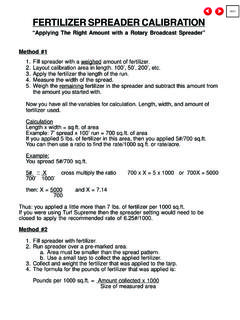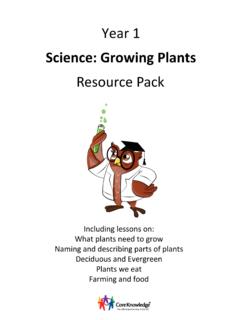Transcription of THE ROLE OF FERTILIZER - Simplot
1 THE ROLE OF FERTILIZERWHY FERTILIZES oils need fertility maintenance. Soil is a natural body offinely divided rocks,minerals and organic matter. Sand,silt, clay and organic matter help provide tilth, necessaryaeration and favorable water intake rates, but they seldommaintain adequate plant food to sustain continuous healthyplant IS FERTILIZER ?There are 17 elements that are known to be essential forplant growth and (also called plant food elements) are materialsproduced to supply these elements in a readily availableform for plant & WATERSOIL & FERTILIZERC arbonNitrogenMagnesiumHydrogenPhosphorus ManganeseOxygenPotassiumMolybdenumSulfur CopperZincCalciumIronChlorineBoronNickle Three of the seventeen essential elements, carbon,hydrogen and oxygen are taken primarily from the air andwater. Oxygen and hydrogen are obtained by plants fromwater. Carbon and hydrogen are taken in by the leavesfrom the air. The other fourteen elements utilized by theplant must come from the soil or from added removal of these elements, plus leaching,volatilization and erosion causes the soil fertility to becontinually reduced.
2 Turf and landscape plants will havepoor color (yellow-green to yellow), poor plant densityallowing weed invasion and low plant vigor which increasesplants suseptibility to disease and insect productivity can be maintained by well managed,scheduled applications of multiple element DOESN T FERTILIZERHAVE 100% PLANT FOOD?A FERTILIZER 16-6-8 analysis adds up to 30% plant food orthirty pounds per hundred pounds of is the other 70%?It is not a filler; it is the way the plant food is chemicallycompounded so plants can utilize can t use elemental nitrogen (N), they only take upnitrogen when it is in the NO3 or NH4 form. This meansthat for each part of nitrogen you have three parts of oxygenwith (NO3) or 4 parts of hydrogen with (NH4). When nitrogenis in a compound which is available to plants, nitrogen isonly part of the compound. The same is true withphosphorus and the other elements. Phosphorus isabsorbed by plants as H2PO4 , HPO4 = or PO4 = dependingupon soil fertilizers were in the elemental form, they would bedifficult to handle:Elemental nitrogen (N) a colorless inert gas that coulddrift off into the phosphorus (P) catches fire spontaneouslywhen exposed to the air.
3 It is actually poisonous to plantsin concentrated potassium (K) placed in contact with waterit will catch fire, explode and decompose into a strongcaustic OF THE 14 ELEMENTS OBTAINEDFROM THE SOIL AND ADDED FERTILIZERA. Primary Plant Food ElementsNitrogenPlants rapidly utilize theseelements and unfertilizedPhosphorussoils normally cannot providethem in quantities needed forPotassium (Potash)best plant (N)1. Promotes rapid vegetative growth (leaf andstems)hastening recovery after mowing and imparting vigorto the A vital element in the formation and function ofchlorophyll the key ingredient imparting dark Synthesizes amino acids which in turn form Regulates the uptake of other Basic ingredient of vital compounds - Nucleic acidand (P)1. Stimulates early root formation and growth getsplants off to a good start and forms a root filter systemin the soil to efficiently pick upthe other available plant nutrients and the strength and stamina of the Hastens maturity (conversion of starch to sugar).
4 3. Stimulates blooming and seed Causes energy transformation and conversionprocesses in which sugars are converted tohormones, protein and energy to grow new leavesand Forms nucleic acids (DNA and RNA).6. Vital for photosynthesis (greening for plants).7. Essential for cell (K)1. Aids in the development of stems and Increases disease resistance and hardiness whichhelps Strengthens cell walls, causing grass to stand up andreduces Affects water intake by plant cells plants withinadequate potassium may wilt in the presence ofample Acts as a catalyst in Iron Essential to the formation and translocation of protein,starches, sugar and oil improving the size and qualityof fruit, grains and Secondary Plant Food ElementsCalciumThey are used in somewhatless quantities than the primaryMagnesiumelements, but they are just asessential for plant growth (Ca)1. Calcium is an essential part of cell wall structureand must be present for the formation of new Deficiency of calcium causes weakened stemsand premature shedding of blossoms and (Mg)1.
5 Essential for photosynthesis (greening of plant).2. Activator for many plant enzymes required ingrowth (S)1. A constituent of three amino acids and is thereforeessential in the formation of SULFUR & GYPSUM RECLAIMSSODIUM SOILSToo much sodiumattached to clayparticles tends tomake the particlespack together insuch a way thatwater cannot materialsfurnish solublecalcium, whichreplaces SODIUMThis replacementallows the soilparticles to groupthemselves sothat larger porespaces CALCIUMThen when the soil is flooded, the watercan pass through and wash out excesssalts, including SALTS2. Helps maintain green color in Improves alkaline Helps compacted soils making them loose andallowing better water Note There are commonly two types of sulfurapplied to plants and soils:Sulfate Sulfur - (SO4); Elemental Sulfur (S)Sulfate Sulfur (SO4)Sulfate Sulfur (SO4) is the form taken up for plant plants require as much sulfur as phosphate intheir growth Sulfur (SO4) is contained in gypsum (CaSO4)and other sulfate fertilizers Ammonium Sulfate,Ammonium Phosphate Sulfate and many turf (CaSO4) will help reclaim alkali soils and makethem loose and friable.
6 Alkali soils contain sodium whichcauses soil to disperse, puddle and seal up. The freecalcium from gypsum will replace the sodium on theclay particle and allow the sodium to be leached out ofthe also causes the small soil particles to flocculate (jointogether in small crumbs), leaving space between themfor air and water Sulfur (S)Elemental Sulfur (S) will convert to sulfate sulfur inthe soil. This reaction can be slow, depending uponthe sulfur particle size and the soil conditions. Onceit has converted to sulfate sulfur (SO4), it is availableto the plant. If the soil contains calcium, it can formgypsum in the soil and be used for reclamation ofalkaline sulfur will lower the pH of the soil at thelocation of the pellet as it converts to sulfate.(See the article on Turf and Sulfur).C. Micronutrients: Iron, Zinc and ManganeseEven though micronutrients are used by plants in verysmall amounts, they are just as essential for plant growthas large amounts of primary and secondary must be maintained in balance in order for allnutrients and water to be used turf grass there are three micronutrients that areparticularly important in order to maintain green colorand plant vigor:Iron (Fe)Yellowing of grass (Iron Chlorosis) is often due toiron deficiency.
7 Iron is required for the formation ofchlorophyll in the plant cell (causes turf to maintain ahealthy green color). It serves as a catalyst for biologicalprocesses such as respiration, symbiotic fixation ofnitrogen and of iron can correct iron deficiency, but itmay be temporary in high pH soils, due to tie up withcalcium. This may require acidification of the soil withelemental sulfur or the use of ammonium forms ofnitrogen or some other acidification agents. Asammonium converts to nitrate in the soil, it has anacidifying effect. This acidifying effect makes iron andmany other elements more available in high pH (Zn)Zinc is an essential component of several plantenzymes. It is a part of auxins and controls the synthesisof indoleacetic acid which regulates growth also affects the intake and efficient use of water (Mn)Manganese serves as an activator for enzymes inplants. Without Manganese, the plants cannot use theiron which they have absorbed.
8 It assists the iron inchlorophyll formation which causes yellowish turf togreen up.













